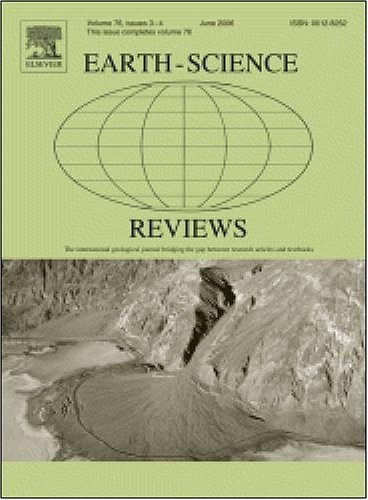西藏东北部新生代古生态演化:磁地层约束下哺乳动物记录综述
IF 10
1区 地球科学
Q1 GEOSCIENCES, MULTIDISCIPLINARY
引用次数: 0
摘要
青藏高原东北部是研究构造、气候和生物演化相互作用的理想实验室。该地区新生代沉积盆地记录了与青藏高原形成和全球气候变化有关的从湿润季风气候向干旱气候演变的生态转变。经过数十年的国际研究,NETP东段的隆中盆地(LB)代表了亚洲最好的大陆记录之一,具有一套全面的气候代用指标,在重建古环境条件和景观演变以及了解其驱动因素方面取得了重大进展。LB还保存了特别丰富且记录良好的哺乳动物化石记录,通过分析分类组成和动物区系特征,为重建古生态条件提供了关键见解。然而,为了更好地理解生态变化的区域模式和驱动因素,还需要对以往的动物记录研究(主要集中在lb的单个子流域)进行综合评估。本文整理了兰州、西宁和临夏亚盆地中最具年代特征和最丰富的陆相哺乳动物化石记录。我们将这些子盆地中所有已发表的哺乳动物化石分类群整合到一个重新评估的可追溯到渐新世的磁地层格架中。随后,我们分配了生态分数来反映这些化石组合所居住的环境,从而使它们的栖息地随时间和空间的半定量重建成为可能。研究结果表明,LB地区在渐新世—中新世早期以开阔林地为主,中新世中期过渡为茂密森林,晚中新世开始演变为稀树草原和草原为主的环境。这些古生态变化得到了区域性哺乳动物化石和基于花粉的生态学研究的支持,与以前从陆地和海洋记录中报道的季风降水模式密切相关。因此,东亚季风降水在晚渐新世至早中新世期间逐渐增强,在中中新世期间明显上升,而在中中新世晚期至第四纪期间周期性大幅度减少。此外,将这些新的古生态学见解与已发表的沉积相、物源和沉积速率数据相结合,使我们能够阐明延伸至晚始新世的区域古生态和地貌演化。在造山带隆升和全球变冷的共同作用下,始新世—渐新世LB地区由低海拔、低起伏、干旱、开阔林地环境的景观逐渐演变为晚中新世—第四纪相对高海拔、高起伏、季风季节性明显、持续干旱、以C4植物为主的景观。本文章由计算机程序翻译,如有差异,请以英文原文为准。
Cenozoic paleoecological evolution of NE Tibet: A review of magnetostratigraphically-constrained mammal records
The northeastern Tibetan Plateau (NETP) is an ideal laboratory for investigating the interplay between tectonics, climate and biotic evolution. Cenozoic sedimentary basins in this region have recorded ecological shifts linked to the evolution from a wetter monsoonal to an arid climate, in response to the formation of the Tibetan Plateau and to global climate variations. Through decades of intense investigations from various international groups, the Longzhong Basin (LB) in the eastern segment of the NETP represent one of Asia's best dated continental records with a comprehensive set of climate proxies that have allowed major advances in the reconstruction of paleoenvironmental conditions and landscape evolution, as well as understanding of their driving forces. The LB also preserves a particularly rich and well-documented mammal fossil record offering key insights for reconstructing paleoecological conditions by analyzing taxonomic compositions and faunal characteristics. However, a comprehensive review synthesizing previous faunal record studies—which have primarily focused on individual sub-basins of the LB—remains to be performed in order to develop an understanding of regional patterns and drivers of ecological shifts. In this review, we compile the best-dated and richest mammalian fossil records of the LB in the Lanzhou, Xining, and Linxia sub-basins. We integrated all published mammalian fossil taxa from these sub-basins into a re-evaluated magnetostratigraphic framework dating back to the Oligocene. Subsequently, we assigned ecological scores to reflect the environments inhabited by these fossil assemblages, thereby enabling a semi-quantitative reconstruction of their habitats over time and space. Our results suggest that the LB region was characterized by open woodland during the Oligocene–Early Miocene, transitioned to dense forest during the Middle Miocene, and evolved into savanna- and steppe-dominated environments beginning in the Late Miocene. These paleoecological changes, as supported by regional mammalian fossil- and pollen-based ecology studies, strongly correlate with monsoonal precipitation patterns previously reported from terrestrial and marine records. Thus, a progressive intensification of East Asian monsoon precipitation in the LB from late Oligocene to the Early Miocene, a pronounced upsurge during the Middle Miocene, and a large periodic reduction from the late Middle Miocene to the Quaternary can be inferred. Furthermore, integrating these new paleoecological insights with published data on sedimentary facies, provenance, and sedimentation rates allows us to elucidate the regional paleoecological and geomorphological evolution extending to the late Eocene. Under the combined influence of orogenic uplift and global cooling, the LB region gradually evolved from low-elevation, low-relief landscapes characterized by drier conditions and open woodland environments following the Eocene–Oligocene Transition to relatively high-elevation, high-relief landscape featuring pronounced monsoonal seasonality, persistently drier conditions, and ecosystems dominated by C4 plants during the Late Miocene–Quaternary.
求助全文
通过发布文献求助,成功后即可免费获取论文全文。
去求助
来源期刊

Earth-Science Reviews
地学-地球科学综合
CiteScore
21.70
自引率
5.80%
发文量
294
审稿时长
15.1 weeks
期刊介绍:
Covering a much wider field than the usual specialist journals, Earth Science Reviews publishes review articles dealing with all aspects of Earth Sciences, and is an important vehicle for allowing readers to see their particular interest related to the Earth Sciences as a whole.
 求助内容:
求助内容: 应助结果提醒方式:
应助结果提醒方式:


